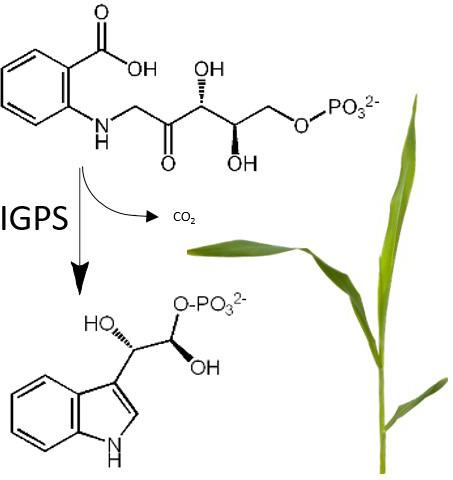Our official English website, www.x-mol.net, welcomes your
feedback! (Note: you will need to create a separate account there.)
Indole‐3‐glycerolphosphate synthase, a branchpoint for the biosynthesis of tryptophan, indole, and benzoxazinoids in maize
The Plant Journal ( IF 6.2 ) Pub Date : 2021-01-18 , DOI: 10.1111/tpj.15163 Annett Richter 1 , Adrian F Powell 1 , Mahdieh Mirzaei 1 , Lucy J Wang 1 , Navid Movahed 1 , Julia K Miller 2 , Miguel A Piñeros 3 , Georg Jander 1
The Plant Journal ( IF 6.2 ) Pub Date : 2021-01-18 , DOI: 10.1111/tpj.15163 Annett Richter 1 , Adrian F Powell 1 , Mahdieh Mirzaei 1 , Lucy J Wang 1 , Navid Movahed 1 , Julia K Miller 2 , Miguel A Piñeros 3 , Georg Jander 1
Affiliation

|
The maize (Zea mays) genome encodes three indole‐3‐glycerolphosphate synthase enzymes (IGPS1, 2, and 3) catalyzing the conversion of 1‐(2‐carboxyphenylamino)‐l‐deoxyribulose‐5‐phosphate to indole‐3‐glycerolphosphate. Three further maize enzymes (BX1, benzoxazinoneless 1; TSA, tryptophan synthase alpha subunit; and IGL, indole glycerolphosphate lyase) convert indole‐3‐glycerolphosphate to indole, which is released as a volatile defense signaling compound and also serves as a precursor for the biosynthesis of tryptophan and defense‐related benzoxazinoids. Phylogenetic analyses showed that IGPS2 is similar to enzymes found in both monocots and dicots, whereas maize IGPS1 and IGPS3 are in monocot‐specific clades. Fusions of yellow fluorescent protein with maize IGPS enzymes and indole‐3‐glycerolphosphate lyases were all localized in chloroplasts. In bimolecular fluorescence complementation assays, IGPS1 interacted strongly with BX1 and IGL, IGPS2 interacted primarily with TSA, and IGPS3 interacted equally with all three indole‐3‐glycerolphosphate lyases. Whereas IGPS1 and IGPS3 expression was induced by insect feeding, IGPS2 expression was not. Transposon insertions in IGPS1 and IGPS3 reduced the abundance of both benzoxazinoids and free indole. Spodoptera exigua (beet armyworm) larvae show improved growth on igps1 mutant maize plants. Together, these results suggest that IGPS1 and IGPS3 function mainly in the biosynthesis of defensive metabolites, whereas IGPS2 may be involved in the biosynthesis of tryptophan. This metabolic channeling is similar to, though less exclusive than, that proposed for the three maize indole‐3‐glycerolphosphate lyases.
中文翻译:

吲哚-3-甘油磷酸合酶,玉米中色氨酸、吲哚和苯并恶嗪类生物合成的分支点
玉米(Zea mays)基因组编码三种吲哚-3-甘油磷酸合酶(IGPS1、2和3),催化1-(2-羧基苯基氨基)-l-脱氧核酮糖-5-磷酸转化为吲哚-3-甘油磷酸。另外三种玉米酶(BX1,无苯并恶嗪酮 1;TSA,色氨酸合酶 α 亚基;和 IGL,吲哚甘油磷酸裂解酶)将吲哚-3-甘油磷酸转化为吲哚,后者作为挥发性防御信号化合物释放,也可作为前体色氨酸和防御相关苯并恶嗪类化合物的生物合成。系统发育分析表明,IGPS2 与在单子叶植物和双子叶植物中发现的酶相似,而玉米 IGPS1 和 IGPS3 位于单子叶植物特异性进化枝中。黄色荧光蛋白与玉米 IGPS 酶和吲哚-3-甘油磷酸裂解酶的融合均位于叶绿体中。在双分子荧光互补试验中,IGPS1 与 BX1 和 IGL 相互作用强烈,IGPS2 主要与 TSA 相互作用,而 IGPS3 与所有三种吲哚-3-甘油磷酸裂解酶相互作用相同。而IGPS1和IGPS3 的表达是由昆虫喂养诱导的,IGPS2 的表达不是。IGPS1和IGPS3 中的转座子插入降低了苯并恶嗪类化合物和游离吲哚的丰度。Spodoptera exigua(甜菜夜蛾)幼虫在igps1突变体玉米植物上表现出改善的生长。总之,这些结果表明 IGPS1 和 IGPS3 主要在防御代谢物的生物合成中起作用,而 IGPS2 可能参与色氨酸的生物合成。这种代谢通道类似于为三种玉米吲哚-3-甘油磷酸裂解酶提出的代谢通道,但不那么排他性。
更新日期:2021-01-18
中文翻译:

吲哚-3-甘油磷酸合酶,玉米中色氨酸、吲哚和苯并恶嗪类生物合成的分支点
玉米(Zea mays)基因组编码三种吲哚-3-甘油磷酸合酶(IGPS1、2和3),催化1-(2-羧基苯基氨基)-l-脱氧核酮糖-5-磷酸转化为吲哚-3-甘油磷酸。另外三种玉米酶(BX1,无苯并恶嗪酮 1;TSA,色氨酸合酶 α 亚基;和 IGL,吲哚甘油磷酸裂解酶)将吲哚-3-甘油磷酸转化为吲哚,后者作为挥发性防御信号化合物释放,也可作为前体色氨酸和防御相关苯并恶嗪类化合物的生物合成。系统发育分析表明,IGPS2 与在单子叶植物和双子叶植物中发现的酶相似,而玉米 IGPS1 和 IGPS3 位于单子叶植物特异性进化枝中。黄色荧光蛋白与玉米 IGPS 酶和吲哚-3-甘油磷酸裂解酶的融合均位于叶绿体中。在双分子荧光互补试验中,IGPS1 与 BX1 和 IGL 相互作用强烈,IGPS2 主要与 TSA 相互作用,而 IGPS3 与所有三种吲哚-3-甘油磷酸裂解酶相互作用相同。而IGPS1和IGPS3 的表达是由昆虫喂养诱导的,IGPS2 的表达不是。IGPS1和IGPS3 中的转座子插入降低了苯并恶嗪类化合物和游离吲哚的丰度。Spodoptera exigua(甜菜夜蛾)幼虫在igps1突变体玉米植物上表现出改善的生长。总之,这些结果表明 IGPS1 和 IGPS3 主要在防御代谢物的生物合成中起作用,而 IGPS2 可能参与色氨酸的生物合成。这种代谢通道类似于为三种玉米吲哚-3-甘油磷酸裂解酶提出的代谢通道,但不那么排他性。











































 京公网安备 11010802027423号
京公网安备 11010802027423号